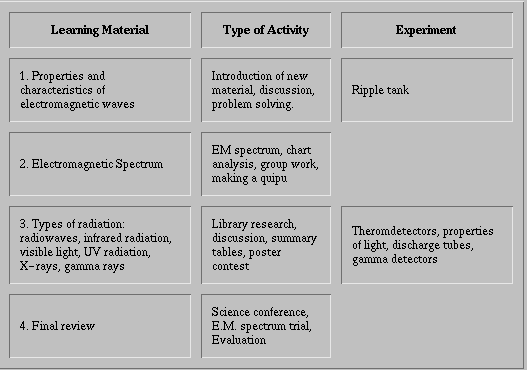©1995 The Regents of the University of California
![]()
![]()
The most important step in the process of the unit development is to build a skeleton of the material to be presented and the activities to be used in class. This one logical format of the electromagnetic radiation unit that can be most effective.

![]()
(1) Electromagnetic Waves
The first couple of days should be devoted to discussing the general properties of electromagnetic waves. The direction of such class discussions and the complexity of material will depend on how well the students are prepared for the material. Pre-test that includes general questions can help a teacher identify the level of student preparedness. At this stage, the goal is to show the students the differences and similarities between waves existing only in a medium and electromagnetic waves. The following summary charts and diagrams can be helpful.
An interesting and non-traditional way to summarize and review the material studied in this unit is to put the electromagnetic spectrum On Trial
It may be helpful to show a diagram depicting basic properties of waves. The second stage is to combine all electromagnetic waves in one spectrum. The main goal is to show the students different options for such a spectrum: vertical or horizontal, according to the wavelength or frequency of radiation. It is very important to demonstrate different types of electromagnetic spectrum charts taken from different sources (textbooks, encyclopedia, etc.). In addition, the teacher can give students assignments to develop their own spectrum structures based on other principles. Here is an example of one way to represent the different types of electromagnetic radiation.
After quipus are constructed, groups can exchange them and try to decipher the coded information by analyzing how the strings are grouped together, how many strings there are in each group, and according to what pattern the knots are arranged. Here is an example of an electromagnetic spectrum quipu based on frequency. First string represents the speed of light. It is considered to be a key string that gives the idea of how to insert numbers with scientific notations using different types of knots. Other six strings represent six types of electromagnetic waves (from radio waves to gamma rays.)
(3) Types of Radiation: sources and properties
The next, and perhaps, central part of this unit is a detailed description of each type of radiation and how astronomers use electromagnetic radiation as a probe to study different objects in our Universe. Some key concepts include how radiation interacts with matter, being "dispersed," absorbed and emitted by atoms.
Here is a diagram that can be useful in a simplified discussion of how the hydrogen atom absorbs and emits radiation . In this diagram you can see how continuum, emission and absorption spectra are produced by the interaction of electromagnetic radiation with a gas such as hydrogen.
Once the students understand how the different types of spectra can be produced, they will be ready to make their own model of a star (most of which are sources of absorption spectra) such as the one shown here.
(4) Examples of Real Data: Continuum, Emission, and Absorption Spectra
Here is an example of a continuum spectrum from a white dwarf star called HZ43, taken with the EUVE satellite. In this example we see extreme ultraviolet electromagnetic photons from the white dwarf HZ43 at wavelengths ranging from 80 to 700 Angstroms.
You may be interested in this example of an emission spectrum from a molecular cloud of gas called W51, located in our Milky Way galaxy. In this example we see radio electromagnetic photons from the W51 molecular cloud at a frequency of 113 Gigahertz.
Or, try this example of an absorption spectrum from a star called Arcturus, located in our Milky Way galaxy. In this example we see visible electromagnetic photons from Arcturus centered at a wavelength of 4300 Angstroms.
(5) Group Activities for Students
To increase efficiency and to avoid repetition, it is logical to organize the whole process in the form of independent work in small groups. The whole class is divided into six groups, which are assigned to investigate a type of radiation in accordance with a certain format.
Students are responsible for organizing library research using school and public libraries, conducting experiments under the teacher's supervision, filling out a special summary table (the table should be big enough to be posted in class), and making group presentations of their investigations in front of the class.
The final presentation and summary table should include the following information: Type of radiation, astronomical sources, artificial sources, properties, methods of detection, discovery, and wavelength/frequency.
(6) Recapitulation and Review
There are different ways to review the material studied in the unit and to prepare students for the test. Class discussions, review worksheets, or a movie about electromagnetic waves are among possible activities. Another interesting form of a review lesson could be a science conference entitled "Electromagnetic radiation in astrophysics." Students can use charts, tables, slides, OHPs, and even VCRs to support their ideas while making presentations. The following are some of the possible topics for discussion:
Astrophysics: Elective Subject for High School Students
More Details on This Unit
Mail comments to outreach@ssl.berkeley.edu